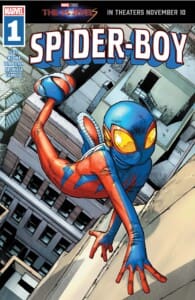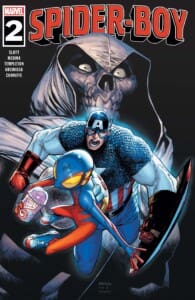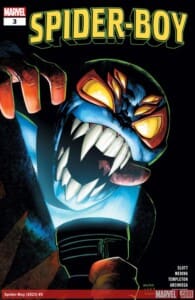The Spider-Verse is a wildly fascinating construct within Marvel Comics and both the Sony and Marvel realms of Spider-man.

One of the results of the Spider-Verse’s fallout was the restoration of a Spider Totem known as Bailey Briggs aka Spider-Boy. At one point, was Spider-man’s sidekick but was erased from the collective consciousness of everyone in his world. The first three issues of his solo title (written by Dan Slott and Humberto Ramos) finds Bailey trying to re-acclimate himself back into a world where no one, not even his biological mother (who we’ve yet to see) even knows of him.
To make matters worse, Bailey was crossed with an actual spider by the evil scientist/villain Madame Monstrosity, who has a Dr. Moreau-esque menagerie of humans crossed with various animals. So, at the worst times, Bailey turns from a human boy into a human/spider amalgam complete with huge fans and multiple eyes — which of course is caught on camera and sensationalized by Robbie Robertson and The Daily Bugle staff (much to the anger of Peter Parker).

The first three issues are separated into two distinct storylines. These stories differ in tone, tenor, and even illustration. The first half of the book is slickly and beautifully drawn and deal with Madame Monstrosity as well as the societal pressure of being a hero while still being viewed as a literal monster by the public, and dealing with the fallout of absolutely no one remembering who he is.
In the first three books we see him battling Helefino, a creation of Madame Monstrosity, The Taskmaster (along side a very supportive Captain America) and Killionaire — a villainous social media star.
The second half of the book is styled in a throwback ’80s style of comic book that feels way more kid-friendly and has a much more positive spin on Bailey and his life than the first half of the book. Here he teams with Squirrel Girl to battle an evil balloon villain and with Thor to help him understand the motivations of a monster (which gives the frightened crowds at the scene an A ha! moment for Bailey’s spider persona).

This split book style is a wonderful read. While the styles and vibes are essentially different, Bailey never changes. He’s a kid who’s very misunderstood by the public, but will put his feelings aside to save people’s lives. He delivers really silly puns at a moment’s notice, and he’s a fiercely loyal friend to Spider-Man and Christina Wu, who is essentially his adopted big sister. There’s really good messaging in these books about acceptance and inclusivity that will resonate with younger readers (and that’s never a bad thing). And while the books focus on a much younger hero, it’s still a highly relatable and compelling read for those of us with grey in our hair.
A personal aside — Dan Slott’s works have been recommended to me for years by our managing editor. This is the first series I’ve ever checked out of his, and I will see that I am hooked on his style. I cannot wait to dive into his back catalog to read his other stories.

